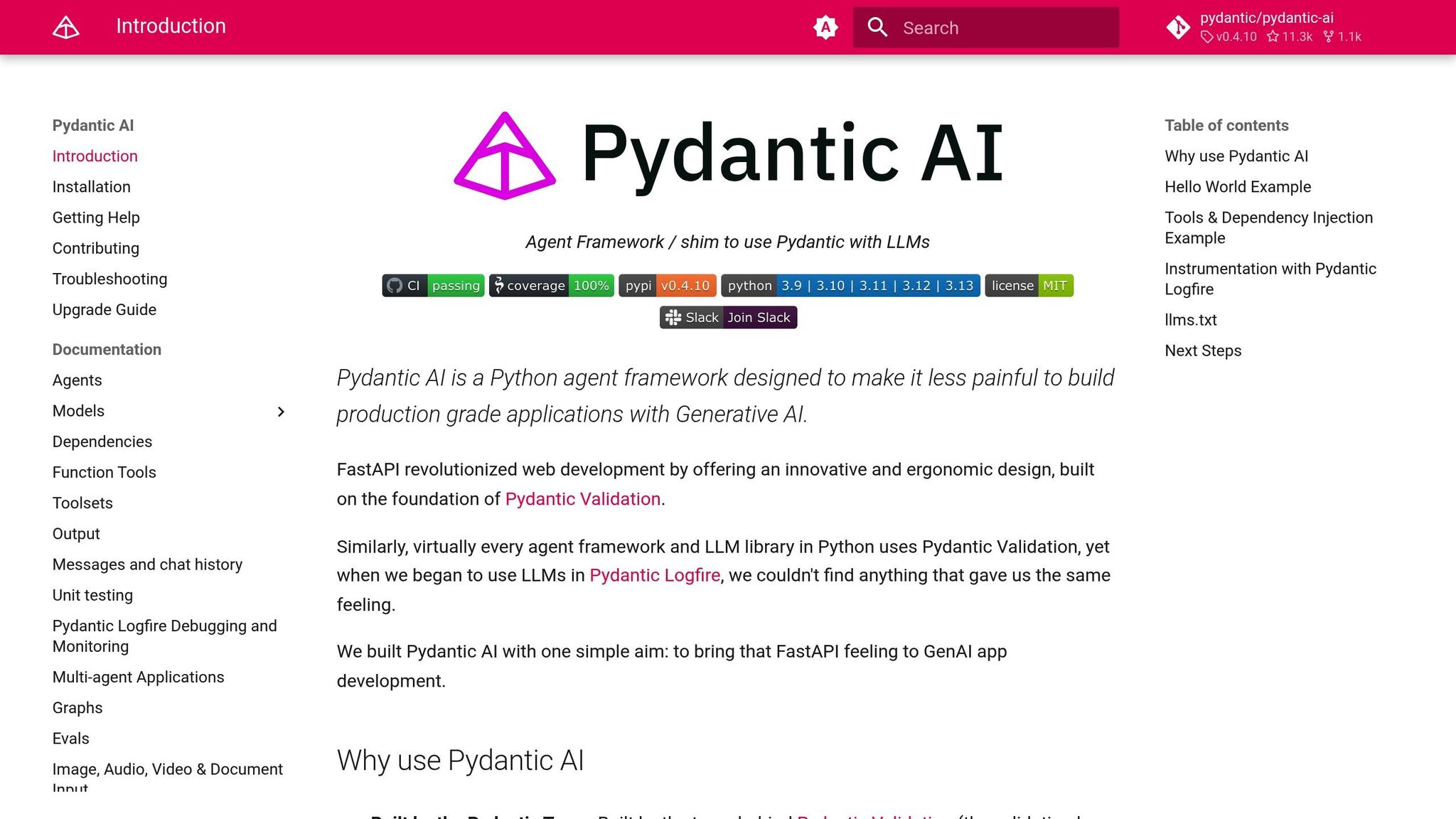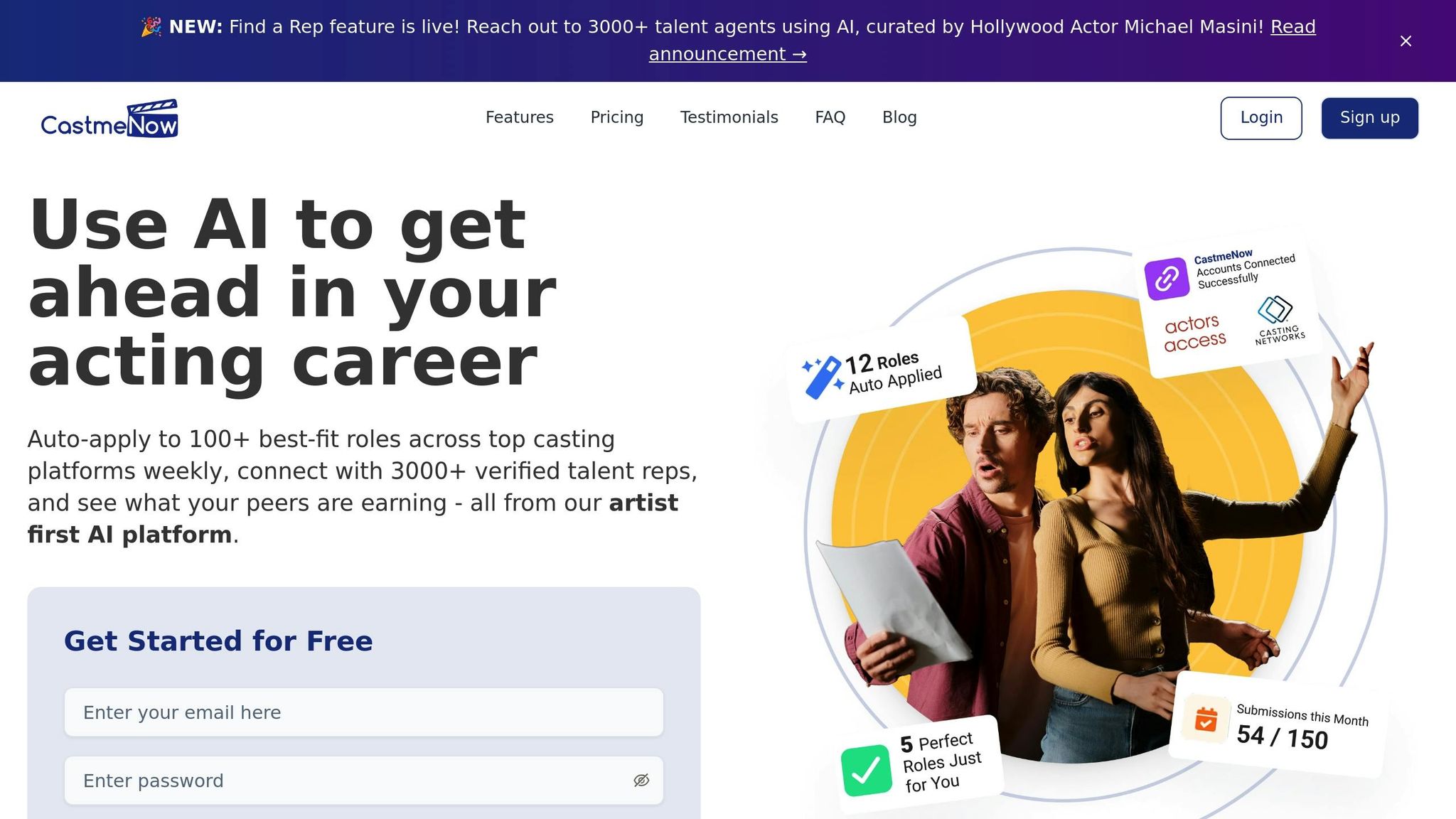How Scalable APIs Improve Casting Automation
Explore how scalable APIs are revolutionizing casting automation by enhancing efficiency, security, and real-time data management.

Scalable APIs are transforming casting automation by streamlining processes, reducing manual tasks, and improving efficiency. They enable real-time data sharing between casting platforms, talent databases, and automation tools, ensuring faster and more accurate role matching. Key features like stateless architecture, caching, and rate limiting allow these systems to handle high traffic without compromising performance.
Key Takeaways:
- Efficiency Boost: Automates tasks like profile matching and application submissions.
- Core Features: Stateless design for reliability, REST/GraphQL protocols for flexibility, and caching for speed.
- Scalability: Horizontal scaling and load balancing manage traffic spikes during peak casting periods.
- Security: OAuth 2.0, HTTPS encryption, and access controls protect sensitive actor data.
Platforms like CastmeNow demonstrate the power of scalable APIs, offering 24/7 automation, analytics, and smart role matching to help actors seize opportunities faster and more effectively.
Your AI Agents Are Useless Without This: PydanticAI + FastAPI Crash Course

Key Features of Scalable APIs in Casting Automation
When it comes to designing casting automation systems, scalable APIs play a pivotal role. These APIs need to be built with architectural principles that ensure reliability, speed, and the ability to scale. Why? Because modern casting workflows demand systems that can handle everything from processing thousands of applications at once to maintaining smooth performance during peak casting seasons. Let’s break down the key features that make this possible.
Stateless Architecture for Better Performance
A stateless architecture is at the heart of scalable casting systems. In this setup, each API request is self-contained - it includes all the data needed to process it without relying on previous sessions or stored information.
What does this mean in practice? For example, when an API compares actor profiles to casting requirements, each request operates independently. If a server goes down, the system can instantly reroute the request to another server without missing a beat. This independence also makes scaling straightforward - new servers can be added on the fly to handle traffic spikes, keeping the system responsive no matter the load.
API Protocols: REST and GraphQL
Casting automation often uses a mix of REST and GraphQL protocols to meet different needs:
- REST APIs are perfect for straightforward tasks like submitting applications. They excel at caching data that doesn’t change often, such as actor headshots, resumes, or basic profile details.
- GraphQL, on the other hand, offers more flexibility. It lets systems fetch exactly the data they need in a single query, making it ideal for complex operations. Plus, it supports real-time notifications, which are invaluable for sending immediate casting alerts.
Rate Limiting and Caching Systems
To keep casting systems stable and responsive, rate limiting and caching are indispensable tools. Here’s why they matter:
"API rate limiting involves using a mechanism to control the number of requests an API can handle in a certain time period. It's a key process for ensuring that APIs perform to a high level, provide a quality user experience, and protect the system from overload." - Kong
- Rate Limiting: This feature is crucial when thousands of actors are using the system simultaneously. Techniques like the token bucket algorithm manage traffic bursts effectively, while sliding window approaches smooth out traffic flow. Dynamic rate limiting can even reduce server load by up to 40% during peak times. Given that API attacks are projected to increase by 996% by 2030, these safeguards are becoming more important than ever.
- Caching: Caching stores frequently accessed data, like actor profiles or audition schedules, closer to where it’s needed. In-memory solutions such as Redis or Memcached can dramatically cut response times and reduce server strain. For example, static data like headshots or casting requirements can be cached to ensure faster access and smoother user experiences.
| Feature | Benefit in Casting Automation |
|---|---|
| Rate Limiting | Prevents excessive requests, ensuring fair access for all users and maintaining system stability. |
| Caching | Speeds up responses by storing frequently accessed data, improving performance and user satisfaction. |
These features work together to create a solid foundation for casting automation systems. They ensure that platforms can handle the demands of the industry while delivering the speed and reliability that actors and casting directors rely on. By incorporating these principles, casting platforms can achieve secure and scalable API integration tailored to the needs of modern workflows.
Infrastructure Strategies for Scaling Casting Automation
Creating a dependable infrastructure for casting automation takes thoughtful planning and smart execution. These systems need to handle both quiet periods and sudden surges in activity, such as when casting calls for popular productions go live. The challenge lies in scaling to meet these demands without sacrificing performance, efficiency, or cost-effectiveness. Below, we explore how load balancing, horizontal scaling, and other strategies help manage these dynamic needs.
Load Balancing and Horizontal Scaling
Load balancing acts as the traffic manager for casting automation platforms, ensuring incoming requests are evenly distributed across multiple servers. This prevents any single server from becoming overwhelmed. Imagine a scenario where a high-profile casting call goes live - thousands of actors could submit their applications within minutes. Without proper load balancing, the servers might crash under the strain.
Horizontal scaling is another key approach to handling these traffic spikes. Instead of upgrading a single server to make it more powerful (vertical scaling), horizontal scaling adds more servers to share the workload. This method works particularly well in cloud-based systems, where additional servers can be automatically deployed during peak demand periods.
"Load balancing is one of the key pillars of modern distributed systems, playing a critical role in ensuring system scalability, reliability, and fault tolerance." - dev.to
Different algorithms cater to specific needs. For example:
- Round Robin ensures even distribution of requests.
- Least Connections directs traffic to the least busy servers.
- Weighted Round Robin prioritizes higher-capacity servers, which is useful for handling large file uploads.
Health checks play a vital role in keeping the system reliable. These automated checks constantly monitor servers to ensure they are operational. If a server fails, the load balancer removes it from rotation, so actors won't face interruptions when submitting applications.
Cloud platforms like AWS, Google Cloud, and Azure further enhance scalability with auto-scaling features that adjust resources based on real-time traffic.
Database Scaling and Data Management
Managing data efficiently is crucial for the performance and reliability of casting platforms, especially when they handle millions of actor profiles, casting requirements, and application histories. Database scaling ensures that as the platform grows, the database can keep up with increasing demands.
Sharding is one method of scaling, where data is divided across multiple servers based on factors like geographic region or production type. This prevents a single database from becoming a bottleneck during high-traffic periods.
Replication creates copies of the database across multiple servers, boosting both availability and fault tolerance. If the primary database experiences an issue, replicas can immediately take over, ensuring uninterrupted access for users.
Caching helps by storing frequently accessed data - like actor headshots or popular casting categories - in high-speed storage. This reduces the load on primary databases and speeds up response times during heavy usage.
The need for effective data management is only increasing. The global data management and analytics market, for instance, is projected to grow at a CAGR of 16% and reach $513.3 billion by 2030. Poor data quality, on the other hand, costs companies nearly $13 million annually.
Automation in database management is another game-changer. Tasks like data backups, performance tuning, and error detection can be automated, reducing the chance of human error and freeing up technical teams to focus on improving the platform.
System Monitoring and Error Recovery
Continuous monitoring is the backbone of a reliable casting automation system. By tracking metrics like server load, response times, database query speeds, and error rates, technical teams can identify and resolve issues before they disrupt the user experience.
Automated error recovery systems add another layer of reliability. If a server crashes during a busy casting period, these systems can restart services, redirect traffic, and alert administrators - all within seconds of detecting the problem.
Redundancy is also critical. Backup systems, duplicate servers in different locations, and alternative network routes ensure the platform remains functional even if a component fails. For example, if one database goes offline, a backup can immediately take over without affecting users.
Another approach is immutable infrastructure, where faulty components are replaced rather than repaired. When something breaks, the system swaps it out with a fresh, pre-configured component. This reduces errors and ensures consistency.
| Infrastructure Best Practice | Benefit for Casting Automation |
|---|---|
| Automated Monitoring | Detects performance issues early, preventing disruptions to casting submissions |
| Redundant Systems | Keeps the platform running smoothly, even during component failures |
| Immutable Infrastructure | Reduces errors and maintains consistent system performance |
A modular infrastructure design also simplifies scaling and maintenance. Instead of relying on a monolithic system that requires full updates, modular setups let teams upgrade individual components without affecting the entire platform. This flexibility is especially useful when adding new features or integrations.
Secure API Integration with Casting Platforms
When casting automation platforms connect with services like Casting Networks and Actors Access, security becomes a top priority. These integrations deal with sensitive actor information - think headshots, personal details, and career histories - and a single breach could compromise countless profiles and erode trust in the platform. Strong security measures are vital to protect this data while ensuring seamless functionality.
User Authentication and Access Control
The foundation of secure API integration lies in robust authentication protocols. Using OAuth 2.0, an industry standard, casting platforms can access third-party services without exposing user credentials. This method relies on token-based access, such as JSON Web Tokens (JWT), which can be revoked instantly if compromised, reducing potential risks.
"Securing APIs is essential to protect sensitive data, ensure compliance, and prevent cyber threats." - Gyan Chawdhary, VP, Kontra Application Security Training
To further enhance security, platforms should incorporate multi-factor authentication (MFA) and role-based access controls. These measures ensure users only have access to the information they need. For instance, an actor using a platform like CastmeNow might have read-only access to casting calls but full control over their personal profile. Practices like token rotation and adhering to the principle of least privilege further limit exposure to breaches. Beyond authentication, careful data handling is critical to meet privacy and compliance standards.
Data Privacy and Legal Compliance
U.S. data privacy regulations, such as the CCPA and CPRA, mandate that platforms only store the minimum necessary personal data and keep it updated. Casting automation platforms must ensure they comply by avoiding indefinite storage of outdated or unnecessary information.
All API communications should use HTTPS with TLS 1.2 or higher, and sensitive data must be encrypted both in transit and at rest. Maintaining detailed audit logs helps track activity and detect any unusual behavior. Additionally, platforms must implement clear consent mechanisms so actors understand what data is being accessed and how it will be used. Securing data goes hand in hand with controlling access and preventing misuse, which leads to the next layer of protection.
Preventing Abuse and Managing Traffic
To defend against misuse and traffic overloads, platforms should implement rate limiting and API gateway filters. Input validation further protects against injection attacks. When traffic limits are exceeded, strategies like exponential backoff can help manage spikes by gradually increasing the delay between retries.
Real-time monitoring and alert systems provide visibility into potential threats, enabling quick responses to anomalies. By layering these security measures, platforms create a robust defense system. Even if one layer fails, others remain in place to protect sensitive actor information and maintain trust in the casting automation process.
Case Study: How CastmeNow Uses Scalable APIs

CastmeNow Platform Overview
CastmeNow serves as an automation layer designed to work seamlessly with major casting platforms. Instead of functioning as a standalone service, it acts as a smart bridge, connecting actors' profiles across multiple platforms and automating the often time-consuming task of applying for roles - all day, every day.
Here’s how it works: CastmeNow links directly to actors' existing profiles on various casting platforms. It analyzes available opportunities based on each actor's preferences and automatically submits applications around the clock. This approach saves countless hours by eliminating the need for manual submissions. By leveraging APIs, CastmeNow has positioned itself as a leader in casting automation.
The platform offers two subscription tiers: a basic plan at $3 per month for up to 10 automated applications daily, and an unlimited plan at $8 per month, which includes advanced analytics. Both plans come with a 30-day free trial - no credit card required - so users can explore the platform's full capabilities before committing. This subscription model is built on a scalable and secure API framework, which we’ll dive into next.
CastmeNow's API Architecture in Action
At the heart of CastmeNow is an API architecture designed to handle high-demand scenarios while maintaining top-notch security. The system uses a stateless design and horizontal scaling to manage fluctuating workloads effectively.
"Much like a great UI is designed for optimal user experience, a great API is designed for optimal consumer experience." - Uri Sarid, CTO of Mulesoft
The API follows key principles of scalability, including resource-oriented design, rigorous monitoring, and robust security protocols. According to a 2023 Apigee report, 82% of developers prioritize scalability when designing APIs. CastmeNow embraces horizontal scaling by adding servers instead of upgrading hardware, allowing the system to handle thousands of requests per second, with peaks reaching hundreds of thousands. To maintain stability, the platform incorporates rate limiting and caching mechanisms, ensuring fair and efficient access for all users.
Security is a top priority. CastmeNow uses OAuth 2.0 for authentication and HTTPS with TLS encryption for secure data transmission. This ensures that sensitive actor information - such as headshots, personal details, and career histories - remains protected throughout the automation process.
Actor Benefits from CastmeNow's Automation
Thanks to its scalable architecture, CastmeNow provides actors with practical, results-driven advantages. By automating the application process and offering analytics on success rates, the platform helps actors refine their casting strategies.
The intelligent role-matching system filters opportunities to ensure applications align with an actor’s career goals and casting requirements. For those on the Unlimited plan, the platform offers over 25 tools for automation and analytics, providing insights into application trends and success rates.
The 24/7 automation ensures timely submissions, eliminating the delays associated with manual processes. Meanwhile, the analytics features help actors identify which roles generate the best responses, allowing them to tweak their preferences and make smarter career choices.
In addition to benefiting its users, CastmeNow’s efficient use of scalable APIs reduces operational costs while maintaining high-quality service. This balance of innovation and practicality underscores the platform’s value for actors navigating the competitive world of casting.
The Future of Casting Automation with Scalable APIs
Scalable APIs are reshaping the way actors connect with casting opportunities. By improving efficiency, reducing costs, and encouraging technological advances, they lay the groundwork for a more agile and capable casting process.
AI is driving the next big leap forward. The AI industry is projected to hit $1,339 billion by 2030, growing at an annual rate of 35.7%. In casting, this growth means smarter role matching, predictive analytics, and workflows tailored to actors' individual preferences. As AI becomes more integrated, APIs will play an even larger role in powering these cutting-edge casting solutions.
Hyperautomation, which combines AI, machine learning, and robotic process automation, is transforming API management. This approach reduces costs, improves efficiency, and simplifies complex processes.
API-first development strategies are becoming the standard, offering flexibility and faster delivery of new features. Meanwhile, real-time capabilities - enabled by tools like GraphQL and asynchronous APIs - ensure instant updates on new roles, allowing actors to respond swiftly. Edge computing also plays a role by reducing latency and supporting decentralized systems.
Recent data shows a 73% increase in AI-related API traffic on Postman and predicts that 60% of enterprises will adopt AI-powered API strategies by 2026. This growing reliance on advanced API tools means casting platforms will continue to evolve, incorporating more sophisticated features.
Security is also advancing, with zero-trust models and AI-based threat detection enhancing protection. On top of that, resilience techniques like circuit breakers, intelligent retries, and automated performance optimization are boosting system reliability.
These technological improvements reduce the time spent on administrative tasks, allowing actors to focus more on their craft. Platforms like CastmeNow are already showcasing how scalable APIs can handle thousands of applications while delivering actionable insights and analytics. This means actors can expect more personalized experiences and better role-matching algorithms.
FAQs
How do scalable APIs make casting automation more efficient?
Scalable APIs play a key role in casting automation by facilitating quick and dependable data exchange between platforms. This smooth integration cuts down on manual work, speeding up processes and reducing the risk of errors, which leads to more efficient workflows.
Because they can handle growing demands, scalable APIs ensure that automation systems keep up with higher workloads without losing performance. This means users benefit from real-time updates, streamlined operations, and significant time savings - all while maintaining precision and dependability.
How does API security ensure the protection of sensitive actor data in casting automation?
API security plays a crucial role in safeguarding sensitive actor information during casting automation. By utilizing tools like authentication, encryption, and real-time monitoring, platforms can protect personal data - such as profiles and contact information - from unauthorized access or potential breaches.
These measures do more than just prevent data leaks; they help platforms stay aligned with privacy regulations like GDPR. For example, platforms like CastmeNow, which streamline casting processes by integrating with actor profiles and automating applications, depend on strong security protocols to manage large amounts of sensitive data both securely and effectively.
How do REST and GraphQL protocols enhance the flexibility and efficiency of casting automation?
REST and GraphQL in Casting Automation
When it comes to casting automation, REST and GraphQL protocols are game-changers, offering streamlined ways to manage data and processes.
REST operates through a standardized HTTP framework, making it simple to connect with different systems and devices. This compatibility is key for ensuring casting processes run smoothly across multiple platforms without hiccups.
Meanwhile, GraphQL brings a more tailored approach. It lets users request exactly the data they need - no more, no less. This minimizes unnecessary data transfers, which is a big win for performance, especially in intricate casting workflows where speed and precision are non-negotiable.
Together, these protocols support real-time updates, personalized configurations, and the flexibility to adapt to changing industry demands. They ensure casting automation remains efficient and ready to meet user expectations.

